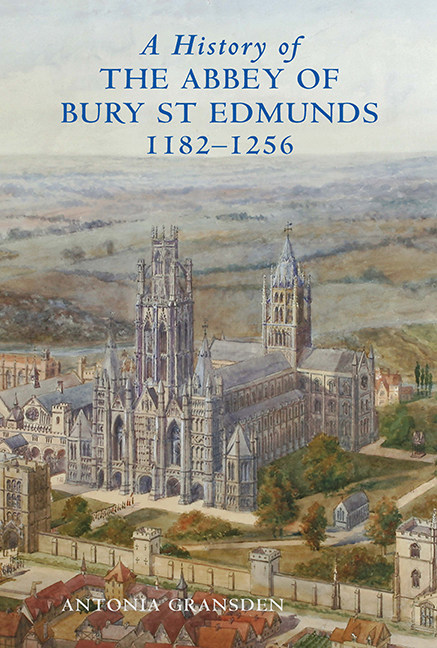Book contents
- Frontmatter
- Dedication
- Contents
- List of plates
- List of figures
- Preface
- Editorial Note
- Epigraph
- Acknowledgements
- Maps and plans (figures 1–9)
- Part I Samson of Tottington, Abbot 1182–1211
- 1 Samson's biographer, Jocelin of Brackland (de Brakelond), and his work
- 2 Samson's early life and career
- 3 Samson's election to the abbacy
- 4 The early years of Samson's abbacy and reform of estate management
- 5 Conflict with the convent
- 6 Relations with the town of Bury St Edmunds
- 7 Samson and secular law
- 8 Samson and the knights of St Edmund
- 9 Relations with the Angevin kings
- 10 Samson and the papacy
- 11 Samson as a builder
- 12 Religious and intellectual life under Samson
- 13 Samson's death and burial
- PART II The Abbey 1212–1256
- APPENDICES
3 - Samson's election to the abbacy
from Part I - Samson of Tottington, Abbot 1182–1211
Published online by Cambridge University Press: 29 April 2017
- Frontmatter
- Dedication
- Contents
- List of plates
- List of figures
- Preface
- Editorial Note
- Epigraph
- Acknowledgements
- Maps and plans (figures 1–9)
- Part I Samson of Tottington, Abbot 1182–1211
- 1 Samson's biographer, Jocelin of Brackland (de Brakelond), and his work
- 2 Samson's early life and career
- 3 Samson's election to the abbacy
- 4 The early years of Samson's abbacy and reform of estate management
- 5 Conflict with the convent
- 6 Relations with the town of Bury St Edmunds
- 7 Samson and secular law
- 8 Samson and the knights of St Edmund
- 9 Relations with the Angevin kings
- 10 Samson and the papacy
- 11 Samson as a builder
- 12 Religious and intellectual life under Samson
- 13 Samson's death and burial
- PART II The Abbey 1212–1256
- APPENDICES
Summary
Late in January or early in February, 1182, Henry II wrote ordering Prior Robert and twelve monks, who were to be unanimously chosen by the monks, to appear before him to elect an abbot. The convent accordingly chose twelve monks. Samson was one of them. These twelve, together with the prior, Robert, were to act as electors, but they knew that the king had control over the appointment: since the abbot, like the head of any great religious house, was a tenant-in-chief, the king could withhold temporalities – the abbot's barony. The monks had to reconcile royal power with the prescriptions of canon law, the Rule of St Benedict and St Edmunds’ own privileges. The Rule established that an abbot was to be chosen either unanimously by the whole community, or by some part of the community, however small, which is of ‘saner counsel’. In 1158 Pope Adrian IV in his confirmation of St Edmund's privileges added the stipulation that the election of abbots should be by common consent of the brethren or of the ‘saner part’ of the community ‘according to the Rule of the blessed Benedict’. In 1162 Alexander III in his confirmation of St Edmunds’ privileges and property reiterated much of Adrian's bull including the passage on abbatial elections. Then, in 1164 Henry II, during his dispute with Archbishop Thomas Becket and his supporters, issued the Constitutions of Clarendon which set out the ‘customs, liberties and privileges’ enjoyed by his ancestors, notably by Henry I. Clause 12 of the Constitutions concerns the election of archbishops, bishops and the heads of religious houses: it states that the king should summon ‘the more important ecclesiastics’ (‘potentiores personas ecclesie’) and that the election should take place in the royal chapel, ‘with the assent of the lord king and with the counsel of the clergy of the realm (‘assensu domini Regis et consilio personarum regni’) summoned for that purpose; the elect should there do homage and fealty to the king as his liege lord for his life, limbs and earthly honour before he is consecrated’.
This clause was a codification of existing procedure which was established by the compromise agreed between Henry I and Archbishop Anselm in 1103.
- Type
- Chapter
- Information
- A History of the Abbey of Bury St Edmunds, 1182–1256Samson of Tottington to Edmund of Walpole, pp. 17 - 22Publisher: Boydell & BrewerPrint publication year: 2007



